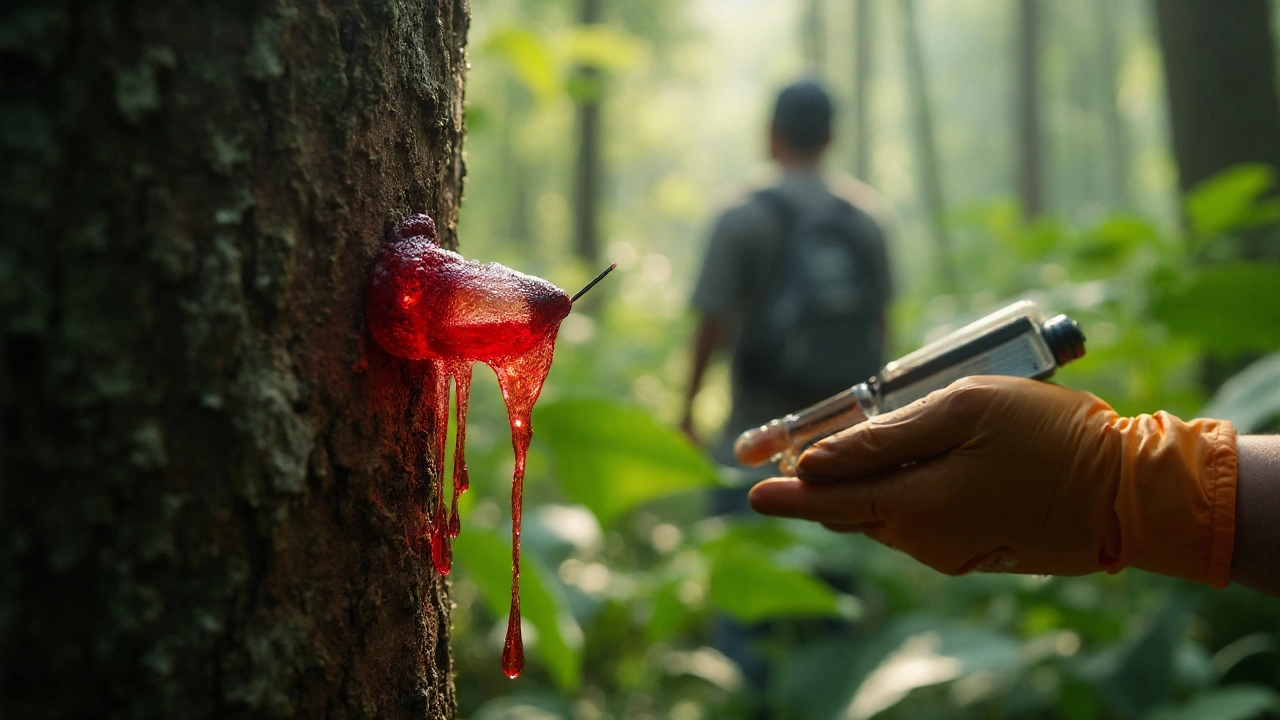Hype is easy. Results are not. Dragon’s blood sounds mythical, but it’s a real plant resin with real research behind some uses-mainly gut support. If you’re looking for a safe, grounded way to upgrade your wellness routine, here’s what it can and cannot do, how to pick a trustworthy product in the UK, and how to fit it into your day without wrecking your digestion or your budget.
- TL;DR
- What it’s good for: short-term diarrhoea support and possibly IBS-D; topical wound/skin calming has some evidence.
- What it’s not great for: weight loss, anti-ageing, or vague “detox” claims-no solid proof.
- Safety: usually well tolerated short-term; avoid if pregnant, breastfeeding, or constipated; space away from iron and medicines by 2-3 hours.
- UK 2025: quality and legal status vary by species and format-buy from reputable brands, check for the Latin name and lab testing.
- No standard dose: start low, follow the label, and stop if stools get too firm.
What Dragon’s Blood Is-and What It Can (and Can’t) Do
“Dragon’s blood” is the deep red sap from a few different plants. The three big ones you’ll see on labels:
- Croton lechleri (South American tree). The best-studied for gut support. The prescription drug crofelemer (approved in 2012 for non-infectious diarrhoea in adults with HIV/AIDS) comes from this sap-useful context for how the resin works in the intestine.
- Daemonorops draco (Southeast Asian palm). More traditional use for wound healing and as a dye; less human research for oral use.
- Dracaena cinnabari or draco (Socotra/Canary Islands). Historically used, limited modern clinical data.
The active compounds vary by species. Croton lechleri sap contains proanthocyanidins that help regulate intestinal fluid secretion (this is how crofelemer works-by modulating chloride channels in the gut). Because supplements aren’t drugs, they’re not purified to the same standard, and their effects are milder and more variable.
Evidence snapshot:
- Acute diarrhoea/traveller’s diarrhoea: Small randomized, placebo-controlled trials of standardized Croton lechleri sap extract (sometimes called SP-303 in the literature) showed shorter duration and fewer stools versus placebo, typically by about a day. These were adult studies with short use (1-3 days).
- IBS-D (diarrhoea-predominant IBS): Limited pilot data suggest some people report calmer stools; high-quality trials are sparse. If you swing constipated, skip it-it may firm things up too much.
- Topical wound/skin: Lab and small clinical studies show the resin helps form a protective film, reduces redness, and may speed minor wound closure. That’s why you see dragon’s blood in serums and gels.
- Other claims (immunity, anti-ageing, weight loss): Not supported by strong human data.
Bottom line: the best-supported use is short-term help when your gut is too loose. Everything else is early-stage or marketing.
Is It Right for You? Quick Decision Guide
Match your goal to what dragon’s blood can realistically do.
- If your main issue is loose stools or travel tummy: Reasonable to try. Expect a gentle firming effect within 24-48 hours if it’s going to help.
- If you have IBS-D: May help as part of a plan that also covers diet, stress, and sleep. Track results for 2 weeks. If you alternate with constipation, be cautious.
- If you have IBS-C or chronic constipation: Not a good fit. It can make stools firmer.
- If you want general “detox” or anti-ageing: Save your money; choose clearer wins (fibre, protein, sleep, strength training).
- If you’re pregnant, breastfeeding, under 18, or have a bleeding disorder: Skip it-insufficient safety data.
Simple rule of thumb: use it as a short-term tool for too-loose stools, not as a daily multivitamin stand-in.
How to Add It to Your Routine (UK 2025)
Formats you’ll see:
- Capsules: Easiest to dose. Look for the species name (ideally Croton lechleri) and standardized extract details.
- Tinctures/liquids: Flexible dosing. Taste is bitter. Ideal if you prefer to start very low.
- Powders: Less common; can clump and stain. Harder to manage dose and taste.
- Topicals: Gels/serums for skin only-do not ingest.
Dosage guidance (there’s no universal standard):
- Start low: 1 capsule (or the minimum liquid dose on the label) with a meal once daily for 2-3 days.
- Adjust based on stool form: If still loose, increase to the typical label dose split 2-3 times per day. If stools turn hard or you feel crampy, back down or stop.
- Short-term use: For acute episodes, think 1-3 days. For IBS-D, trial 1-2 weeks max, then reassess.
- Spacing: Keep 2-3 hours apart from medicines and iron or zinc supplements-tannins can reduce absorption.
When to take it: Pair with meals if you’re sensitive, or between meals if you want a quicker gut effect. Hydration helps-aim for clear or pale-yellow urine.
Stacking it smartly (optional):
- With electrolytes during travel tummy: Good combo to avoid dehydration.
- With probiotics (Lactobacillus rhamnosus GG or Saccharomyces boulardii): Reasonable for short bouts of diarrhoea; the timing matters less than consistency.
- With zinc carnosine for gut lining support: Often well tolerated; watch for nausea at higher zinc doses.
What to avoid:
- Doubling up with multiple astringent herbs (high-tannin blends) without a plan-you could overshoot into constipation.
- Using it to mask symptoms you should check (blood in stool, fever, unexplained weight loss, severe pain). See your GP or NHS 111.

Quality, Safety, and Interactions You Shouldn’t Ignore
Not all products sold as dragon's blood supplement are the same. Here’s how to buy safely in the UK in 2025.
- Check the Latin name on the label. For gut support, Croton lechleri is the most relevant. If it just says “dragon’s blood” with no species, pass.
- Look for lab testing. Ask the brand for a batch Certificate of Analysis (CoA) showing identity, heavy metals, microbes, and pesticides. Many reputable UK brands provide QR codes.
- Avoid bright, unnaturally red powders. Cheap products are sometimes dyed. The real sap is dark and stains but shouldn’t look neon.
- Mind the law. The UK follows food supplement rules (FSA). Novel food status depends on the ingredient and history of use. If a brand can’t confirm compliance, don’t buy.
Who should not take it:
- Pregnant or breastfeeding: No solid safety data; avoid.
- Children: Not studied; avoid unless a clinician advises.
- IBS-C/constipation: It can firm stools further.
- Severe heart, liver, or kidney disease: Only under clinical advice.
Interactions and side effects:
- Most common: Firmer stools, reduced frequency, mild cramping, darker stools. Ease the dose if this happens.
- Absorption: The tannins can bind minerals and medicines-space 2-3 hours from prescriptions, especially thyroid meds, antibiotics, and iron.
- Blood thinners: Evidence of a direct effect is limited, but play it safe. If you’re on warfarin or a DOAC, speak to your GP or pharmacist first.
- Allergy: Rare. Stop if you notice rash, itching, or swelling.
Evidence and credibility cues:
- Human trials of standardized Croton lechleri extract for acute diarrhoea were published in peer-reviewed journals in the 1990s-2000s, showing shorter symptom duration versus placebo.
- The FDA-approved botanical drug crofelemer (2012) validates the gut mechanism (chloride channel modulation), even though supplements aren’t the same as the prescription.
- Reviews in the Journal of Ethnopharmacology and pharmacognosy texts highlight resin variability by species-one more reason to check labels.
- UK guidance (FSA/MHRA) treats these as foods unless medicinal claims are made; quality control is the buyer’s responsibility-ask for CoAs.
Cost and value (UK 2025):
- Capsules: £15-£40 per month depending on dose and standardization.
- Liquids: Often pricier per serving; pay attention to mg of extract, not just “drops.”
Buyer’s mini-checklist:
- Species named (Croton lechleri) and extract ratio/standardization listed.
- Third-party tested; recent CoA available.
- Clear dosing and safety language on the label.
- Company provides UK address and customer support; avoids wild claims.
Alternatives and Combos: What Might Work Better for Your Situation
Choosing the right tool saves time and money. Here’s how dragon’s blood stacks up against other gut-support options and when to use which.
| Option | Best For | Evidence Strength (human) | UK Legal Status (2025) | Typical Dose | Common Side Effects | Approx. Monthly Cost (UK) |
|---|---|---|---|---|---|---|
| Dragon’s blood (Croton lechleri) | Short-term loose stools, IBS-D support | Moderate for acute diarrhoea; limited for IBS-D | Food supplement when compliant; check species/CoA | No standard; follow label; start low, split doses | Firmer stools, mild cramping | £15-£40 |
| Saccharomyces boulardii | Antibiotic-associated and traveller’s diarrhoea | Strong for prevention/recovery | Widely available as supplement | 5-10 billion CFU daily | Gas, rare fungal infection in immunocompromised | £10-£25 |
| Lactobacillus rhamnosus GG | Diarrhoea prevention, paediatric use | Strong for specific indications | Supplement; brand-specific evidence | 10-20 billion CFU daily | Bloating, gas | £12-£30 |
| Zinc carnosine | Gastric lining support, mild dyspepsia | Moderate | Supplement | 37.5-75 mg daily | Nausea if taken fasting | £15-£30 |
| Psyllium husk | Stool normalization (both loose and firm) | Strong for stool form and cholesterol | Food/supplement | 3-10 g daily with water | Gas if increased too fast | £5-£12 |
| Berberine | Loose stools from small intestinal overgrowth; glucose control | Moderate for glycaemia; mixed for gut | Supplement; watch interactions | 500 mg 2-3x daily (short term) | GI upset, drug interactions | £15-£35 |
Simple decision rule:
- Want a quick, short-term firming effect? Try dragon’s blood or S. boulardii. If you travel a lot, pack S. boulardii.
- Need daily stool consistency? Psyllium is a cheap, proven base-add dragon’s blood only for flare days.
- Upper gut symptoms (burning, nausea)? Zinc carnosine may be a better fit.
- Blood sugar goals as well? Berberine may be the priority, with medical guidance.
Combining safely: If you stack, change one thing at a time for 7-14 days. Keep a symptom log (stool form 1-7 using the Bristol scale, urgency, pain, bloating). Stop the least helpful item first.
FAQ: Quick Answers to Common Questions
- Is dragon’s blood safe long term? There’s no strong data for long-term daily use. Use it short term or in cycles (e.g., 5 days on, then off) and reassess.
- How fast will it work? If it helps, many notice firmer stools within 24-48 hours.
- Will it constipate me? It can. Start low and stop if stools get hard (Bristol 1-2).
- Can I take it with probiotics? Yes. Timing doesn’t need to be perfect-consistency matters more. Space 2 hours from medicines.
- Which species is best? For gut support, look for Croton lechleri. If the label doesn’t list a Latin name, don’t buy.
- Is it vegan? Yes, the resin is plant-based. Check capsules for gelatin if you’re vegan.
- Sustainability? Ask brands about ethical sourcing. Croton lechleri sap can be harvested without killing the tree when done properly.
- UK legality in 2025? It’s sold as a food supplement when compliant with UK regulations. Novel food status may apply depending on the ingredient history. Buy from reputable UK-registered companies.
- Can I use the skincare version orally? No. Topical gels/serums are not formulated for ingestion.
- Can kids use it? Not recommended without clinical guidance.
- Does it stain teeth? Liquids can stain temporarily. Dilute and rinse after.

Next Steps and Troubleshooting
If you’re ready to try dragon’s blood, keep it simple and measurable. Three short paths based on common scenarios:
- Traveller’s tummy / acute loose stools
- What to do today: Pick a Croton lechleri capsule from a UK brand that provides a CoA. Start at the lowest label dose with your next meal.
- What to add: Rehydration salts. Optional S. boulardii.
- Stop if: You develop fever, blood in stool, severe pain, or no improvement within 48 hours-contact your GP or NHS 111.
- IBS-D management
- What to do today: Add psyllium 1 tsp nightly for 3-5 days. If stools remain loose, add a low dose of dragon’s blood for 7-14 days.
- Track: Use the Bristol stool chart daily plus urgency (0-10). Aim for types 3-4.
- Adjust: Too firm? Reduce dragon’s blood first; keep psyllium steady.
- Skincare-first interest
- What to do today: If your goal is redness or minor skin irritation, choose a topical dragon’s blood gel. Patch test on the inner arm for 24 hours.
- Do not: Take skincare products orally.
When to get help:
- Red flags: Blood in stool, black tarry stools, fever, severe dehydration, weight loss, or persistent change in bowel habits beyond three weeks-book with your GP.
- Medicines: If you’re on warfarin, DOACs, thyroid meds, or antibiotics, speak to a pharmacist about spacing and suitability.
Quick troubleshooting:
- No effect after 3 days: Wrong product (species/under-dosed) or wrong fit for your issue. Switch strategy-consider probiotics or fibre.
- Cramping: Take with food, lower the dose, or stop.
- Nausea from liquids: Dilute in more water or swap to capsules.
Last tip: buy once, test well. A single, well-sourced bottle plus a two-week symptom log will tell you more than months of guesswork.


tony ferreres
September 5, 2025 AT 18:59When we examine any supplement, it’s worth remembering that the body is a dialogue, not a battlefield 🧭. Dragon’s blood offers a modest tool for that conversation, especially when looser stools threaten our equilibrium. Think of it as a temporary bridge rather than a permanent fix, and you’ll avoid the temptation to rely on it forever. In practice, a low dose paired with mindful eating can restore balance without alarming side effects. 🌿
Kaustubh Panat
September 19, 2025 AT 11:47Your gentle analogy sounds charming but completely overlooks the rigorous pharmacology that separates crofelemer from garden‑variety extracts. The market is flooded with sub‑standard products that barely contain Croton lechleri, rendering your “bridge” metaphor a flimsy excuse for poor quality control. Consumers deserve precise standards, not poetic platitudes.
Arjun Premnath
October 3, 2025 AT 04:35It’s encouraging to see the community focusing on evidence‑based uses rather than hype. For short‑term diarrhoea, the data on standardized Croton lechleri extracts are indeed promising, especially when combined with adequate hydration. Adding a probiotic like S. boulardii can further support gut recovery without conflict. Just remember to keep the dosing low and observe stool consistency daily. Consistency in tracking will help you decide when to taper off safely.
Johnny X-Ray
October 16, 2025 AT 21:23Exactly! 🎉 Watching the stool chart shift from frantic to calm feels like watching a sunrise after a storm. I love how the resin can act fast, giving you back control within 24‑48 hours. Pair it with electrolytes and you’ve got yourself a travel‑ready rescue kit. And don’t forget the smile when you finally ditch the bathroom dash! 😄
tabatha rohn
October 30, 2025 AT 13:11Anyone still touting dragon’s blood as a cure‑all is delusional. 🙄
Mark Rohde
November 13, 2025 AT 05:59Delusional? Absolutely-this “miracle” resin is nothing more than a marketing ploy💥 no real data supports the lofty claims. The only thing it seems to do is empty wallets and give false hope.
Rajan Desai
November 26, 2025 AT 22:47Observing the current supplement landscape, one notes a pattern where botanical extracts are presented with grandiose health promises while rigorous clinical validation remains scarce. The emphasis on proper species identification, such as Croton lechleri, underscores the necessity for transparency in labeling. Consumers should prioritize products that provide third‑party certificates of analysis, ensuring both safety and potency. Moreover, integrating such supplements with established dietary strategies can enhance overall gastrointestinal health without reliance on singular interventions.
S O'Donnell
December 10, 2025 AT 15:35It is with a profound sense of scholarly duty that I address the preceding discourse regarding the utilization of Dragon’s blood as a therapeutic adjunct for gastrointestinal perturbations. While the afore‑mentioned assertions commendably highlight the necessity for species verification and third‑party testing, they regrettably omit a comprehensive appraisal of the pharmacokinetic parameters that fundamentally govern the bioavailability of proanthocyanidins within the intestinal milieu. One must consider, for instance, the degree of polymerization of these polyphenolic constituents, as their molecular weight exerts a determinative influence upon mucosal absorption and subsequent systemic distribution. Moreover, the interaction of tannin‑rich extracts with dietary minerals such as iron and zinc induces chelation phenomena that may attenuate the nutritive efficacy of concurrently administered supplements, a nuance insufficiently elucidated in the prior commentary. It would further be prudent to juxtapose the clinical outcomes observed in randomized controlled trials of crofelemer-an FDA‑approved analogue derived from Croton lechleri-against the heterogeneous efficacy reported in open‑label investigations of over‑the‑counter preparations. Such comparative analyses elucidate a salient disparity in magnitude of effect, thereby cautioning against the uncritical extrapolation of pharmaceutical data to nutraceutical contexts. Additionally, the temporal dynamics of symptom amelioration merit scrutiny; while anecdotal reports purport rapid amelioration within twenty‑four hours, the extant literature typically documents a latency period extending to seventy‑two hours before statistically significant reductions in stool frequency emerge. The ramifications of this lag for patients with acute traveller’s diarrhoea are nontrivial, necessitating adjunctive rehydration strategies to mitigate the risk of dehydration during the interim. Furthermore, the regulatory landscape within the United Kingdom, particularly in relation to novel food status, imposes stringent criteria for market authorization that may impinge upon the availability of high‑purity extracts, a consideration that was superficially addressed in the earlier missive. In concluding, while the enthusiasm for botanical therapeutics is undeniably commendable, a judicious approach predicated upon meticulous evaluation of pharmacodynamic properties, interaction potential, and regulatory compliance remains paramount, lest we inadvertently substitute speculative optimism for evidence‑based medical practice.